These acorn worms have a head for swimming

Certain marine worms spend their larval phase as little more than a tiny, transparent “swimming head.” A new study explores the genes involved in that headfirst approach to life.
A mud flat in Morro Bay, Calif., is the only known place where this one species of acorn worm, Schizocardium californicum, is found. After digging up the creatures, Paul Gonzalez, an evolutionary developmental biologist at Stanford University, raised hordes of the larvae at Stanford’s Hopkins Marine Station in Pacific Grove, Calif.
Because a larva and an adult worm look so different, scientists wondered if the same genes and molecular machinery were involved in both phases of development. To find out, Gonzalez and colleagues analyzed the worm’s genetic blueprint during each phase, they report online December 8 in Current Biology.
Genes linked to trunk development were switched off during the larval phase until just before metamorphosis. Instead, most of the genes switched on were associated with head development, Gonzalez says.
The larvae hatch from eggs laid on the mud. When tides flood the area, the squishy, gel-filled animals use hairlike cilia to swim upwards to devour bits of algae. “They’re feeding machines,” Gonzalez says. He speculates that being balloon-shaped noggins, rather than wriggling noodles, may help the organisms float and feed more efficiently.
After about two months of gorging at the algae buffet, the larvae, which grow to roughly 2 millimeters across, transform and sink back into the muck. There, they eventually grow a body that can stretch up to about 40 centimeters.